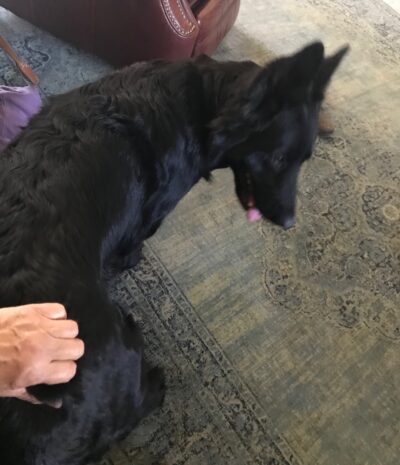By Fran Jewell

It’s funny to watch dogs play and make new friends. They speak to each other with their bodies, which is so fascinating. One of the most common behaviors is that one dog will stick its rear end in the face of another dog. This behavior can have many meanings in the dog world, like almost any behavior. We humans like to compartmentalize behaviors—one meaning to each behavior. It seems to make the dog world easier for us to understand. But, that simply is not true. Just like our human language, one word can have many meanings, like the word “run.” Merriam-Webster lists EIGHT different meanings of the word “run.” Incredible! I have watched dog behavior for a profession, as a competitor and for public service (search and rescue and pet therapy) day in and day out for almost 30 years. I listen and watch other dog experts all the time and not a day goes by that I don’t learn a new meaning to a dog behavior that I didn’t know before.
The key is to see any behavior in context. What are the other parts of the dog describing? It’s just like us seeing a word in a complete sentence to understand the word meaning at that time. When we start to understand dog behavior, we realize that the more we know, the more we DON’T KNOW! We begin to watch the entire dog to help us understand.
In some cases, the butt move can be a flirtatious advance from a female to a male to let him know she would like his attention. It can be a simple friendship gesture, from one dog to another. Since dogs also sniff each other’s rears as a greeting, this is an invitation to a new dog to meet each other. The underlying theme is that when a dog faces away from you, or the other dog, it usually means that he or she does not mean harm. By moving their heads away from you or another dog, it signifies that the dog has no intention of biting or disciplining; it is friendly. When we scratch him above his tail, it is our acknowledgement to the dog that we accept his friendship gesture, and no, we don’t have to sniff him!
With a change in mood, a dog turning his back on you can also mean he does not feel comfortable with you or the other dog, and is trying to make the situation less stressful. In that context, the dog may also move away in the opposite direction. This behavior is usually accompanied by a head down, sniffing the ground. But, not always!
The trick to understanding dog behavior is to read the entire sentence; in other words, watch the entire dog. I say “trick” when, in reality, because we don’t speak “dog,” it is really quite complex for most of us humans. Dog language is rarely what we think because we apply our human emotions to it. Dogs have emotions, but they certainly are not the same emotions we humans have about the same stimulus, which is incredibly hard for us to understand. And just like the writings of famous authors, many of us will have different interpretations of their written word.
Fran Jewell is an IAABC Certified Dog Behavior Consultant, NADOI Certified Instructor and the owner of Positive Puppy Dog Training, LLC in Sun Valley. For more information, visit positivepuppy.com or call 208-578-1565.


